| Listing 1 - 10 of 38 | << page >> |
Sort by
|

ISBN: 0471571482 Year: 1995 Volume: *1 Publisher: New York Chichester Brisbane Wiley
Abstract | Keywords | Export | Availability | Bookmark
 Loading...
Loading...Choose an application
- Reference Manager
- EndNote
- RefWorks (Direct export to RefWorks)
Computer simulation --- Computersimulatie --- Simulation par ordinateur --- 519.8 --- Mathematical optimization --- -Numerical analysis --- -Computer simulation --- Computer modeling --- Computer models --- Modeling, Computer --- Models, Computer --- Simulation, Computer --- Electromechanical analogies --- Mathematical models --- Simulation methods --- Model-integrated computing --- Mathematical analysis --- Optimization (Mathematics) --- Optimization techniques --- Optimization theory --- Systems optimization --- Maxima and minima --- Operations research --- System analysis --- Operational research --- Data processing --- Computer simulation. --- Numerical analysis --- Data processing. --- 519.8 Operational research --- Mathematical optimization - Data processing.
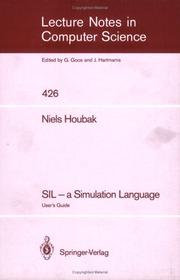
ISBN: 3540524975 0387524975 Year: 1990 Volume: vol 426 Publisher: Berlin : Springer-Verlag,
Abstract | Keywords | Export | Availability | Bookmark
 Loading...
Loading...Choose an application
- Reference Manager
- EndNote
- RefWorks (Direct export to RefWorks)
Computer simulation --- SIL (Computer program language) --- 681.3*D32 --- Programming languages (Electronic computers) --- Computer modeling --- Computer models --- Modeling, Computer --- Models, Computer --- Simulation, Computer --- Electromechanical analogies --- Mathematical models --- Simulation methods --- Model-integrated computing --- language classifications: applicative languages; data-flow languages; design languages; extensible languages; macro and assembly languages; nonprocedural languages; specialized application and very high-level languages (Programminglanguages) --- 681.3*D32 language classifications: applicative languages; data-flow languages; design languages; extensible languages; macro and assembly languages; nonprocedural languages; specialized application and very high-level languages (Programminglanguages)
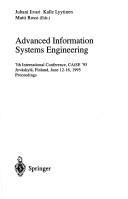
ISBN: 3540594981 3540492909 Year: 1995 Volume: 932 Publisher: Berlin : Springer-Verlag,
Abstract | Keywords | Export | Availability | Bookmark
 Loading...
Loading...Choose an application
- Reference Manager
- EndNote
- RefWorks (Direct export to RefWorks)
This volume constitutes the proceedings of the 7th International Conference on Advanced Information Systems Engineering, CAiSE '95, held in Jyväskylä, Finland in June 1995. The 26 full papers presented in this volume were selected from more than 100 submissions; in addition there are three invited papers. Among the contributing authors are academics as well as information system practitioners from industry and administration. The volume is organized in sections on behaviour modelling, requirements engineering, 00 concepts and applications, work and communication modelling, meta modelling, user interface issues, CASE integration, reuse, conceptual modelling issues, and software development issues.
Computer-aided software engineering --- Congresses --- Information theory. --- Software engineering. --- Computer simulation. --- Database management. --- Computer science. --- Theory of Computation. --- Software Engineering/Programming and Operating Systems. --- Simulation and Modeling. --- Database Management. --- Software Engineering. --- Models and Principles. --- Informatics --- Science --- Data base management --- Data services (Database management) --- Database management services --- DBMS (Computer science) --- Generalized data management systems --- Services, Database management --- Systems, Database management --- Systems, Generalized database management --- Electronic data processing --- Computer modeling --- Computer models --- Modeling, Computer --- Models, Computer --- Simulation, Computer --- Electromechanical analogies --- Mathematical models --- Simulation methods --- Model-integrated computing --- Computer software engineering --- Engineering --- Communication theory --- Communication --- Cybernetics
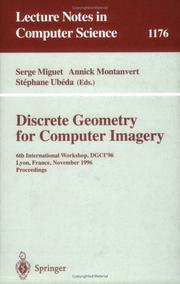
ISBN: 3540620052 3540495959 9783540620051 Year: 1996 Volume: 1176 Publisher: Berlin [etc.] : Springer-Verlag,
Abstract | Keywords | Export | Availability | Bookmark
 Loading...
Loading...Choose an application
- Reference Manager
- EndNote
- RefWorks (Direct export to RefWorks)
This book constitutes the refereed proceedings of the 6th International Workshop on Discrete Geometry for Computer Imagery, DGCI'96, held in Lyon, France, in November 1996. Computer imaging essentially depends on discrete models for coding, processing, recognition, representation, etc. The volume presents 24 revised full papers selected from 41 submissions together with 3 invited contributions and a tutorial paper, which bridges the gap between theory and practice. The issues addressed are topology, geometry, shape representation, 3D surfaces and volumes, models for discrete space, image transformation and generation.
Computer graphics --- Discrete geometry --- Congresses --- Data processing --- Geometry --- Computer simulation. --- Computer vision. --- Computer graphics. --- Discrete groups. --- Visualization. --- Simulation and Modeling. --- Signal, Image and Speech Processing. --- Image Processing and Computer Vision. --- Computer Graphics. --- Convex and Discrete Geometry. --- Groups, Discrete --- Discrete mathematics --- Infinite groups --- Automatic drafting --- Graphic data processing --- Graphics, Computer --- Computer art --- Graphic arts --- Electronic data processing --- Engineering graphics --- Image processing --- Machine vision --- Vision, Computer --- Artificial intelligence --- Pattern recognition systems --- Visualisation --- Imagination --- Visual perception --- Imagery (Psychology) --- Computer modeling --- Computer models --- Modeling, Computer --- Models, Computer --- Simulation, Computer --- Electromechanical analogies --- Mathematical models --- Simulation methods --- Model-integrated computing --- Digital techniques --- Computer graphics - Congresses --- Discrete geometry - Data processing - Congresses.
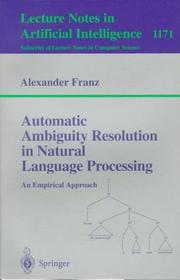
ISBN: 3540620044 3540495932 Year: 1996 Volume: 1171 *147 Publisher: Berlin [etc.] : Springer-Verlag,
Abstract | Keywords | Export | Availability | Bookmark
 Loading...
Loading...Choose an application
- Reference Manager
- EndNote
- RefWorks (Direct export to RefWorks)
This is an exciting time for Artificial Intelligence, and for Natural Language Processing in particular. Over the last five years or so, a newly revived spirit has gained prominence that promises to revitalize the whole field: the spirit of empiricism. This book introduces a new approach to the important NLP issue of automatic ambiguity resolution, based on statistical models of text. This approach is compared with previous work and proved to yield higher accuracy for natural language analysis. An effective implementation strategy is also described, which is directly useful for natural language analysis. The book is noteworthy for demonstrating a new empirical approach to NLP; it is essential reading for researchers in natural language processing or computational linguistics.
Ambiguity --- Ambiguïteit --- Ambiguïté --- Amphibologie --- Langue naturelle--Traitement des données (Informatique) --- Natural language processing (Computer science) --- Natuurlijke taal--Gegevensverwerking (Informatica) --- Équivoque --- Artificial intelligence. --- Computer simulation. --- Computer science. --- Statistics. --- Artificial Intelligence. --- Simulation and Modeling. --- Mathematical Logic and Formal Languages. --- Statistics for Social Sciences, Humanities, Law. --- Informatics --- Science --- Computer modeling --- Computer models --- Modeling, Computer --- Models, Computer --- Simulation, Computer --- Electromechanical analogies --- Mathematical models --- Simulation methods --- Model-integrated computing --- AI (Artificial intelligence) --- Artificial thinking --- Electronic brains --- Intellectronics --- Intelligence, Artificial --- Intelligent machines --- Machine intelligence --- Thinking, Artificial --- Bionics --- Cognitive science --- Digital computer simulation --- Electronic data processing --- Logic machines --- Machine theory --- Self-organizing systems --- Fifth generation computers --- Neural computers --- Statistical analysis --- Statistical data --- Statistical methods --- Statistical science --- Mathematics --- Econometrics
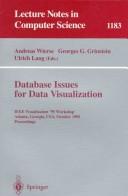
ISBN: 3540622217 3540496815 Year: 1996 Volume: 1183 Publisher: Berlin [etc.] : Springer-Verlag,
Abstract | Keywords | Export | Availability | Bookmark
 Loading...
Loading...Choose an application
- Reference Manager
- EndNote
- RefWorks (Direct export to RefWorks)
This book constitutes the strictly refereed post-workshop proceedings of the Second International Workshop on Database Issues for Data Visualization, held in conjunction with the IEEE Visualization '95 conference in Atlanta, Georgia, in October 1995. Besides 13 revised full papers, the book presents three workshop subgroup reports summarizing the contents of the book as well as the state-of-the-art in the areas of scientific data modelling, supporting interactive database exploration, and visualization related metadata. The volume provides a snapshop of current research in the area and surveys the problems that must be addressed now and in the future towards the integration of database management systems and data visualization.
Database management --- Congresses --- Visualization --- Data structures (Computer scienc. --- Database management. --- Multimedia systems. --- Computer simulation. --- Data Structures and Information Theory. --- Database Management. --- Multimedia Information Systems. --- Simulation and Modeling. --- Data Structures. --- Computer modeling --- Computer models --- Modeling, Computer --- Models, Computer --- Simulation, Computer --- Electromechanical analogies --- Mathematical models --- Simulation methods --- Model-integrated computing --- Computer-based multimedia information systems --- Multimedia computing --- Multimedia information systems --- Multimedia knowledge systems --- Information storage and retrieval systems --- Data base management --- Data services (Database management) --- Database management services --- DBMS (Computer science) --- Generalized data management systems --- Services, Database management --- Systems, Database management --- Systems, Generalized database management --- Electronic data processing
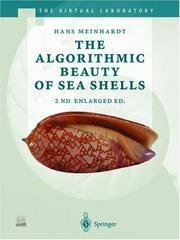
ISBN: 3540639195 3662036193 3662036177 Year: 1998 Volume: *1 Publisher: Berlin Heidelberg New York Springer
Abstract | Keywords | Export | Availability | Bookmark
 Loading...
Loading...Choose an application
- Reference Manager
- EndNote
- RefWorks (Direct export to RefWorks)
The pigment patterns on tropieal shells are of great beauty and diversity. They fas cinate by their mixture of regularity and irregularity. A partieular pattern seems to follow partieular mIes but these mIes allow variations. No two shells are identical. The motionless patterns appear to be static, and, indeed, they consist of calcified material. However, as will be shown in this book, the underlying mechanism that gene rates this beauty is eminently dynamic. It has much in common with other dynamie systems that generate patterns, such as a wind-sand system that forms large dunes, or rain and erosion that form complex ramified river systems. On other shells the underlying mechanism has much in common with waves such as those commonly observed in the spread of an epidemie. A mollusc can enlarge its shell only at the shell margin. In most cases, only at this margin are new elements of the pigmentation pattern added. Therefore, the shell pattern preserves arecord in time of a process that took place in a narrow zone at the growing edge. A certain point on the shell represents a certain moment in its history. Like a time machine one can go into the past or the future just by turning the shell back and forth. Having this complete historieal record opens the possibility of decoding the generic principles behind this beauty. My interest in these patterns began with a dinner in an Italian restaurant.
Pattern formation (Biology) --- Shells --- Computer simulation. --- Computer simulation --- Shells - Computer simulation. --- Pattern formation (Biology) - Computer simulation. --- Computer graphics. --- Bioinformatics . --- Computational biology . --- Computer Graphics. --- Computer Appl. in Life Sciences. --- Simulation and Modeling. --- Computer modeling --- Computer models --- Modeling, Computer --- Models, Computer --- Simulation, Computer --- Electromechanical analogies --- Mathematical models --- Simulation methods --- Model-integrated computing --- Biology --- Bioinformatics --- Bio-informatics --- Biological informatics --- Information science --- Computational biology --- Systems biology --- Automatic drafting --- Graphic data processing --- Graphics, Computer --- Computer art --- Graphic arts --- Electronic data processing --- Engineering graphics --- Image processing --- Data processing --- Digital techniques
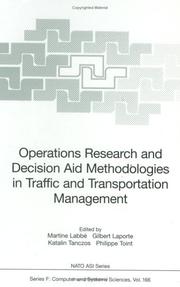
ISBN: 3540646523 3642084281 3662035146 9783540646525 Year: 1998 Volume: 166
Abstract | Keywords | Export | Availability | Bookmark
 Loading...
Loading...Choose an application
- Reference Manager
- EndNote
- RefWorks (Direct export to RefWorks)
Every one relies on some kind of transportation system nearly every day. Go ing to work, shopping, dropping children at school and many other cultural or social activities imply leaving home, and using some form of transportation, which we expect tobe eflicient and reliable. Of course, efliciency and reliabil ity do not occur by chance, but require careful and often relatively complex planning by transportation system managers, both in the public and private sectors. It has long been recognized that mathematics, and, more specifically, op erations research is an important tool of this planning process. However, the range of skills required to cover both fields, even partially, is very large, and the opportunities to gather people with this very diverse expertise are too few. The organization of the NATO Advanced Studies Institute on "Opera tions Research and Decision Aid Methodologies in Traflic and Transportation Management" in March 1997 in Balatonfüred, Hungary, was therefore more than welcome and the group of people that gathered for a very studious two weeks on the shores of the beautiful lake Balaton did really enjoy the truly multidisciplinary and high scientific level of the meeting. The purpose of the present volume is to report, in a chronological order, the various questions that were considered by the lecturers and the' students at the institute. After a general introduction to the topic, the first week focused on issues related to traflic modeling, mostly in an urban context.
Transportation --- Transport --- Mathematical models --- Congresses --- Modèles mathématiques --- Congrès --- Modèles mathématiques --- Congrès --- Computer science—Mathematics. --- Automotive engineering. --- Operations research. --- Decision making. --- Computers and civilization. --- Computer simulation. --- Mathematics of Computing. --- Automotive Engineering. --- Operations Research/Decision Theory. --- Computers and Society. --- Simulation and Modeling. --- Computer modeling --- Computer models --- Modeling, Computer --- Models, Computer --- Simulation, Computer --- Electromechanical analogies --- Simulation methods --- Model-integrated computing --- Civilization and computers --- Civilization --- Deciding --- Decision (Psychology) --- Decision analysis --- Decision processes --- Making decisions --- Management --- Management decisions --- Choice (Psychology) --- Problem solving --- Operational analysis --- Operational research --- Industrial engineering --- Management science --- Research --- System theory --- Decision making --- Transportation - Mathematical models - Congresses

ISBN: 0805827242 Year: 1998 Publisher: London Erlbaum
Abstract | Keywords | Export | Availability | Bookmark
 Loading...
Loading...Choose an application
- Reference Manager
- EndNote
- RefWorks (Direct export to RefWorks)
Artificial intelligence. Robotics. Simulation. Graphics --- AI(Artificial intelligence) --- Acquisition de la connaissance (Systèmes experts) --- Artificial intelligence --- Artificial thinking --- Artificiële intelligentie --- Computer simulation --- Computersimulatie --- Electronic brains --- Intellectronics --- Intelligence [Artificial ] --- Intelligence artificielle --- Intelligent machines --- Kennisverwerving (Expertsystemen) --- Knowledge acquisition (Expert systems) --- Kunstmatige intelligentie --- Machine intelligence --- Simulation par ordinateur --- Thinking [Artificial ] --- Cerveaux électroniques --- Machines intelligentes --- Pensée artificielle --- Acquisition, Knowledge (Expert systems) --- Expertise acquisition (Expert systems) --- Expert systems (Computer science) --- Computer modeling --- Computer models --- Modeling, Computer --- Models, Computer --- Simulation, Computer --- Electromechanical analogies --- Mathematical models --- Simulation methods --- Model-integrated computing --- AI (Artificial intelligence) --- Intelligence, Artificial --- Thinking, Artificial --- Bionics --- Cognitive science --- Digital computer simulation --- Electronic data processing --- Logic machines --- Machine theory --- Self-organizing systems --- Fifth generation computers --- Neural computers --- Artificial intelligence.
Book
ISBN: 901402911X Year: 1980 Volume: vol *50 Publisher: Alphen aan den Rijn Samsom
Abstract | Keywords | Export | Availability | Bookmark
 Loading...
Loading...Choose an application
- Reference Manager
- EndNote
- RefWorks (Direct export to RefWorks)
Investment management --- Information systems --- Computers --- Entreprises --- Ondernemingen --- Ordinateurs --- 681.3*I61 --- 519.86 --- Capital investments --- -Computer simulation --- 681.3*I63 --- 681.3*J4 --- informatica --- vennootschappen --- vzw --- Computer modeling --- Computer models --- Modeling, Computer --- Models, Computer --- Simulation, Computer --- Electromechanical analogies --- Mathematical models --- Simulation methods --- Model-integrated computing --- Capital expenditures --- Capital improvements --- Capital spending --- Fixed asset expenditures --- Plant and equipment investments --- Plant investments --- Investments --- Simulation theory: model classification; continuous simulation; discrete simulation (Simulation and modeling) --- Theory of economic-mathematical models --- Decision making --- -Simulation methods --- Applications (Simulation and modeling) --- Social and behavioral sciences (Computer applications) --- informatique --- societes --- asbl --- Computer simulation. --- Simulation methods. --- 681.3*J4 Social and behavioral sciences (Computer applications) --- 681.3*I63 Applications (Simulation and modeling) --- 519.86 Theory of economic-mathematical models --- 681.3*I61 Simulation theory: model classification; continuous simulation; discrete simulation (Simulation and modeling) --- Computer simulation --- Decision making&delete&
| Listing 1 - 10 of 38 | << page >> |
Sort by
|

 Search
Search Feedback
Feedback About UniCat
About UniCat  Help
Help News
News